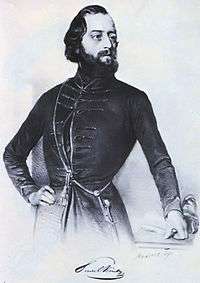Battle of Mór
| Battle of Mór | |||||||
|---|---|---|---|---|---|---|---|
| Part of the Hungarian Revolution of 1848 | |||||||
| |||||||
| Belligerents | |||||||
|
|
| ||||||
| Commanders and leaders | |||||||
|
|
| ||||||
| Strength | |||||||
|
6,500 men 24 cannon | Unknown | ||||||
| Casualties and losses | |||||||
|
2,500 dead or taken prisoner 5 cannon | Unknown | ||||||
The Battle of Mór was a battle in the Hungarian Revolution of 1848, fought on 30 December 1848 between Austria and Hungarian insurgents. The Austrians were led by Croatian Ban Josip Jelačić, while the Hungarians were led by Mór Perczel. The Austrians were victorious and Buda lost it is independence.
Pretext

In the summer of 1848 two separated armies were defending the Western Hungarian borders. Major General Artúr Görgey with his army between Channel Nádas and Lake Fertő was against Alfred I, Prince of Windisch-Grätz. Major General Mór Perczel led approximately 10,000 soldiers and tried to defend Međimurje against Laval Nugent who was stationed at Styria.
Hoping the Austrians would not attack, the Hungarian military leadership started to establish new troops and organise their forces. But, on 14 December, Windisch-Grätz started his attack and this meant a new period of the Revolution. This is called the "Winter Campaign".
The larger Austrian army managed to break through the Hungarian defence. The Hungarian army started to retreat towards Győr and Buda. Lajos Kossuth tried to convince Görgey to continue the fight, and he sent more legions from other theatres of battle to help. On 16 December Perczel received an order that he was to make contact with Görgey. This meant that the Hungarian troops gave up South Transdanubia without a fight.
In his dispatches Kossuth commanded Görgey and Perczel to engage the Austrians. Kossuth made a mistake, as he knew that Perczel needed little encouragement to start a fight. On 30 December Perczel was in Mór when he received Kossuth's letter and, even though his more-educated officers advised him not to fight, he undertook the battle. Before the battle Perczel forgot to inform Görgey of his decision even though he was close by.
Battle

Perczel’s legion contained approximately 6,500 soldiers and 24 cannon. The northern area near Mór was disadvantageous, because it was surrounded by a forest which the Austrians could easily break through. Perczel had determination, and the fact that the Austrians had a smaller army there made him more confident. But he did not reconnoitre the Austrians, so he did not realise how powerful they were.
The Hungarian artillery stopped Jelačić’s front line and they were advancing when Ferenc Ottinger's front line arrived. The balance of forces significantly changed. Jelačić’s legion had fewer soldiers than Perczel’s, but Jelačić and his legion were more powerful.
The weak and barely fighting Hungarian soldiers escaped to the forest. They managed to save almost all of the artillery but Perczel could only reorganize his legion in Székesfehérvár. The loss to Hungary was about 2,500 men, most of them were taken prisoner. They also lost at least 5 cannon.
Aftermath
Hearing the news that Perczel lost the battle, Görgey withdrew again in fear that Jelačić would surround the Hungarian army from the south. The legion on the Upper Danube had to protect almost every road to Buda. Because of this they moved closer to Buda, the capital city, as it was in danger from the Austrians. On 31 December the Government decided to decamp to Debrecen. On 2 January 1849 the Council of War decided not to fight for the empty Buda and Pest. Three weeks after the start of the Winter Campaign Windisch-Grätz marched on Buda.